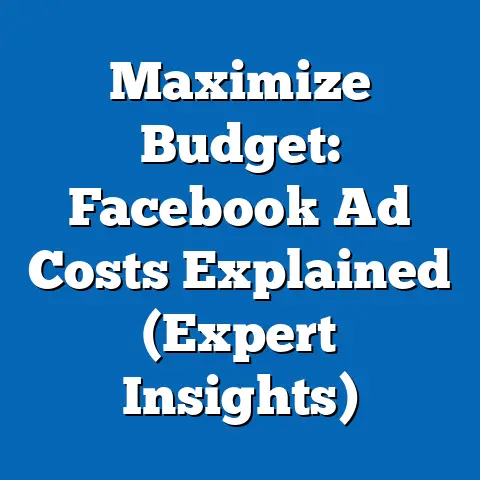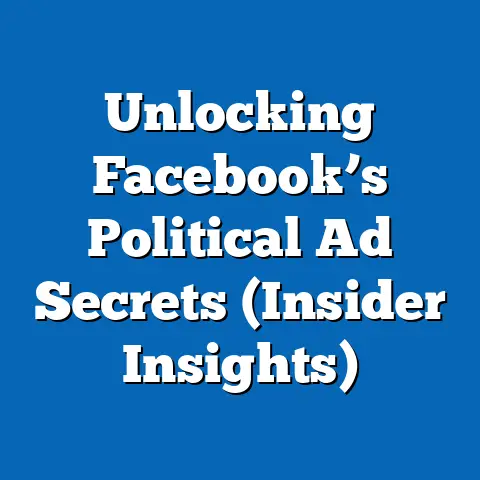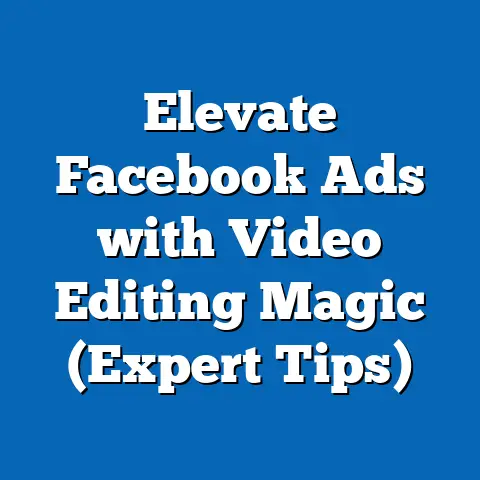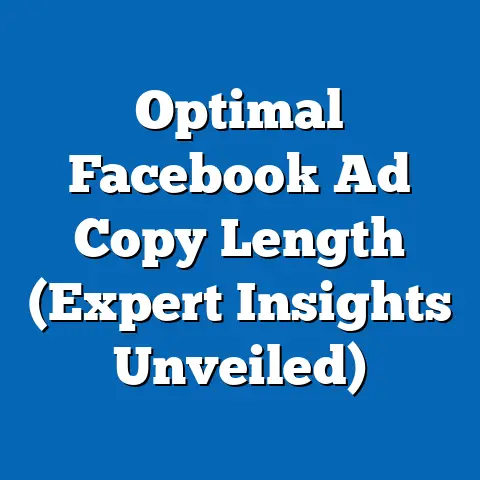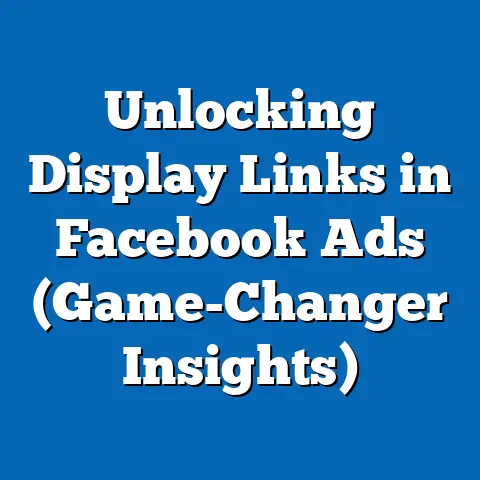Craft Winning Facebook Ads Creatives (Expert Tips Inside)
I’ve seen firsthand the incredible power of a well-crafted Facebook ad. It’s not just about pretty pictures or clever slogans; it’s about connecting with your audience on a deeper level and driving meaningful results. I remember working with a small local bakery that was struggling to attract new customers. Their Facebook ads were bland, generic, and simply weren’t resonating. After a complete creative overhaul, focusing on mouthwatering visuals and compelling storytelling, their online orders skyrocketed. It was a game-changer for their business. That experience solidified my belief that the creative aspect is the heart and soul of any successful Facebook ad campaign.
Section 1: Understanding Facebook Ads Creatives
At its core, a Facebook ad creative is the visual and textual representation of your message designed to capture the attention of your target audience and persuade them to take a specific action. It’s more than just an image or a block of text; it’s a carefully crafted combination of elements working together to create a cohesive and compelling message.
Why are Creatives So Important?
In the fast-paced, attention-deficit world of social media, your ad creative has mere seconds to make an impact. It’s the first thing people see, and it’s what determines whether they’ll stop scrolling and engage with your message. Without a compelling creative, even the most meticulously targeted ad campaign will fall flat.
Think of it like this: you can have the perfect product or service, and the most precise targeting in the world, but if your ad looks like it was designed in 1998, nobody’s going to click.
The Key Components of an Ad Creative:
- Visuals: This includes images, videos, GIFs, and other visual elements. They are often the first thing users notice and play a crucial role in grabbing attention.
- Copy: This is the text that accompanies your visual, including the headline, body text, and description. It’s your opportunity to communicate your message, highlight the benefits of your offer, and persuade users to take action.
- Call-to-Action (CTA): This is the prompt that tells users what you want them to do next, such as “Shop Now,” “Learn More,” or “Sign Up.” A strong CTA is essential for driving conversions.
The Psychology Behind Effective Ad Creatives:
Effective ad creatives tap into basic psychological principles to capture attention and influence behavior. Some key factors include:
- Visual Appeal: Humans are naturally drawn to visually appealing content. High-quality images and videos that are relevant to the target audience are more likely to grab attention.
- Emotional Connection: Ads that evoke emotions, whether it’s humor, nostalgia, or inspiration, are more likely to resonate with users.
- Relevance: Ads that are relevant to the user’s interests and needs are more likely to be noticed and engaged with.
- Clarity: A clear and concise message is essential for conveying your value proposition and persuading users to take action.
Statistics That Speak Volumes:
The impact of well-crafted creatives is undeniable. Here are a few statistics that highlight the importance of investing in high-quality ad creatives:
- Ads with relevant images get 27% more clicks than ads without. (Source: HubSpot)
- Video ads are 5x more engaging than static image ads. (Source: Animoto)
- Personalized ads generate 6x higher revenue than generic ads. (Source: Monetate)
Takeaway: Your Facebook ad creative is the first impression you make on potential customers. By understanding the key components and psychological principles behind effective creatives, you can significantly improve your ad performance and drive better results.
Section 2: The Elements of High-Performing Facebook Ads Creatives
Now that we understand the fundamental importance of ad creatives, let’s dive into the specific elements that make up a high-performing ad.
Visuals: The Power of Imagery
Visuals are the cornerstone of any successful Facebook ad. In a sea of content, a compelling image or video is what stops users in their tracks.
Importance of High-Quality Images and Videos:
Gone are the days of grainy, low-resolution images. Today’s users expect high-quality visuals that are both visually appealing and relevant to the message. Using professional photography or videography can make a significant difference in the perceived value of your ad.
I once saw a furniture company completely revamp their Facebook ads by switching from amateur snapshots to professionally styled photos. The difference was night and day. Their click-through rates doubled, and their sales increased by 40%.
Tips for Selecting the Right Visuals:
- Know Your Audience: Understand what visuals resonate with your target audience. Consider their age, gender, interests, and cultural background.
- Relevance is Key: Choose visuals that are directly related to your product, service, or offer. Avoid using generic stock photos that don’t accurately represent your brand.
- Show, Don’t Tell: Use visuals to demonstrate the benefits of your product or service. Show how it solves a problem or improves the user’s life.
- Use People: Images of people, especially smiling faces, tend to perform well on Facebook. They create a sense of connection and trust.
- Experiment with Video: Video ads are incredibly engaging and can be used to tell a story, demonstrate a product, or share a testimonial.
The Use of Colors, Branding, and Consistency:
- Color Psychology: Colors evoke different emotions and can influence user behavior. Choose colors that align with your brand’s personality and the message you’re trying to convey. For example, blue is often associated with trust and reliability, while red is associated with excitement and energy.
- Branding Consistency: Ensure that your visuals are consistent with your brand’s overall aesthetic. Use your brand colors, fonts, and logo to create a cohesive look and feel.
- Visual Consistency: Maintain visual consistency across all of your Facebook ads. This helps to build brand recognition and create a professional image.
Example:
Let’s say you’re advertising a new line of organic skincare products. Instead of using a generic stock photo of a model with perfect skin, use a high-quality image of the actual products in a natural setting, like a garden or a spa. Show the ingredients, the textures, and the overall aesthetic of the brand.
Compelling Copywriting
While visuals grab attention, it’s the copy that seals the deal. Your ad copy is your opportunity to communicate your value proposition, highlight the benefits of your offer, and persuade users to take action.
Elements of Effective Ad Copy:
- Headline: The headline is the first thing users read, so it needs to be attention-grabbing and concise. It should clearly communicate the main benefit of your offer.
- Body Text: The body text provides more detail about your product or service. It should highlight the key features, benefits, and value proposition.
- Description: The description is a short summary of your offer that appears below the headline. It should reinforce the main benefit and encourage users to click.
Formulas for Writing Headlines and Body Text:
- Problem/Agitation/Solution (PAS): Identify a problem your target audience is facing, agitate the pain points associated with that problem, and then present your product or service as the solution.
- Example: “Tired of dry, flaky skin? (Problem) Itchy, uncomfortable, and embarrassing? (Agitation) Discover our new organic skincare line that will leave your skin feeling hydrated, smooth, and radiant! (Solution)”
- Attention/Interest/Desire/Action (AIDA): Grab the user’s attention, pique their interest, create a desire for your product or service, and then prompt them to take action.
- Example: “Attention: Skincare lovers! (Attention) Discover the secret to glowing, healthy skin. (Interest) Imagine waking up every morning with a radiant complexion. (Desire) Shop our new organic skincare line now and get 20% off your first order! (Action)”
- Benefit-Driven: Focus on the key benefits of your product or service.
- Example: “Get younger-looking skin in just 30 days! Our new anti-aging serum is clinically proven to reduce wrinkles and fine lines.”
- Example: “Tired of dry, flaky skin? (Problem) Itchy, uncomfortable, and embarrassing? (Agitation) Discover our new organic skincare line that will leave your skin feeling hydrated, smooth, and radiant! (Solution)”
- Example: “Attention: Skincare lovers! (Attention) Discover the secret to glowing, healthy skin. (Interest) Imagine waking up every morning with a radiant complexion. (Desire) Shop our new organic skincare line now and get 20% off your first order! (Action)”
- Example: “Get younger-looking skin in just 30 days! Our new anti-aging serum is clinically proven to reduce wrinkles and fine lines.”
The Importance of Tone and Voice:
Your ad copy should be consistent with your brand’s tone and voice. Are you playful and humorous, or serious and professional? Use language that resonates with your target audience and reflects your brand’s personality.
Examples of Successful Ad Copy:
Let’s look at a few examples of successful ad copy and analyze what makes them effective:
-
Example 1: Grammarly
- Headline: “Great Writing, Simplified.”
- Body Text: “Improve your writing with Grammarly’s AI-powered assistant. Get real-time feedback on grammar, spelling, punctuation, and style.”
- CTA: “Get Grammarly – It’s Free!”
- Analysis: This ad copy is clear, concise, and benefit-driven. It highlights the key features of Grammarly and offers a free trial to encourage users to sign up.
-
Example 2: Shopify
- Headline: “Start Your Online Store Today.”
- Body Text: “Shopify makes it easy to create a beautiful online store and start selling your products online. Get a free 14-day trial.”
- CTA: “Start Free Trial”
- Analysis: This ad copy is simple, direct, and action-oriented. It clearly communicates the value proposition of Shopify and offers a free trial to incentivize users to try the platform.
Example 1: Grammarly
- Headline: “Great Writing, Simplified.”
- Body Text: “Improve your writing with Grammarly’s AI-powered assistant. Get real-time feedback on grammar, spelling, punctuation, and style.”
- CTA: “Get Grammarly – It’s Free!”
- Analysis: This ad copy is clear, concise, and benefit-driven. It highlights the key features of Grammarly and offers a free trial to encourage users to sign up.
Example 2: Shopify
- Headline: “Start Your Online Store Today.”
- Body Text: “Shopify makes it easy to create a beautiful online store and start selling your products online. Get a free 14-day trial.”
- CTA: “Start Free Trial”
- Analysis: This ad copy is simple, direct, and action-oriented. It clearly communicates the value proposition of Shopify and offers a free trial to incentivize users to try the platform.
Call-to-Action (CTA)
The call-to-action (CTA) is the final piece of the puzzle. It’s the prompt that tells users what you want them to do next. A strong CTA is essential for driving conversions and achieving your advertising goals.
Significance of a Strong CTA:
Without a clear and compelling CTA, users are less likely to take the desired action. They may be interested in your product or service, but they won’t know what to do next.
Tips for Crafting Persuasive CTAs:
- Use Action Verbs: Start your CTA with an action verb, such as “Shop,” “Learn,” “Sign Up,” or “Download.”
- Create Urgency: Use language that creates a sense of urgency, such as “Limited Time Offer” or “Shop Now Before It’s Too Late.”
- Highlight the Benefit: Emphasize the benefit of taking the desired action, such as “Get a Free Trial” or “Save 20% Today.”
- Be Specific: Tell users exactly what they’ll get when they click the CTA, such as “Download Your Free Ebook” or “Shop Our New Collection.”
Placement and Visibility of CTAs:
Your CTA should be prominently displayed within your ad creative. It should be easy to see and understand. Consider using a button or a contrasting color to make it stand out.
Examples of Effective CTAs:
- Shop Now
- Learn More
- Sign Up
- Download Now
- Get Started
- Claim Your Offer
- Book Now
Takeaway: High-performing Facebook ads creatives are a carefully crafted combination of visuals, copy, and CTAs. By focusing on quality, relevance, and persuasion, you can create ads that capture attention, engage your audience, and drive conversions.
Section 3: Tailoring Your Creatives to Your Audience
Creating effective Facebook ads isn’t just about having great visuals and compelling copy; it’s about understanding who you’re talking to. Tailoring your creatives to your specific audience is paramount for achieving optimal results.
The Importance of Audience Research:
Before you even think about designing your ad, you need to know your audience inside and out. This involves understanding their demographics, interests, behaviors, and pain points. The more you know about your audience, the better you can tailor your creatives to resonate with them.
Methods for Understanding Your Audience:
- Facebook Audience Insights: This tool provides valuable data about your target audience, including their demographics, interests, page likes, and location.
- Customer Surveys: Ask your existing customers about their needs, preferences, and motivations. This can provide valuable insights for crafting targeted ad creatives.
- Website Analytics: Analyze your website traffic to understand who’s visiting your site, what pages they’re viewing, and how they’re interacting with your content.
- Social Media Listening: Monitor social media conversations to understand what your target audience is talking about, what their pain points are, and what solutions they’re looking for.
Segmenting Your Audience:
Once you’ve gathered data about your audience, you can segment them into smaller groups based on shared characteristics. This allows you to create more targeted and relevant ad creatives for each segment.
Common segmentation criteria include:
- Demographics: Age, gender, location, education, income
- Interests: Hobbies, passions, activities
- Behaviors: Purchase history, website activity, social media engagement
- Life Events: New job, marriage, graduation
Tailoring Creatives to Different Segments:
Once you’ve segmented your audience, you can tailor your ad creatives to speak directly to each segment’s unique needs and interests.
- Visuals: Use images and videos that resonate with each segment’s visual preferences. For example, if you’re targeting millennials, you might use trendy, authentic visuals. If you’re targeting baby boomers, you might use more traditional, polished visuals.
- Copy: Use language that resonates with each segment’s communication style. For example, if you’re targeting Gen Z, you might use slang and humor. If you’re targeting professionals, you might use more formal and technical language.
- Offers: Tailor your offers to each segment’s specific needs and pain points. For example, if you’re targeting new parents, you might offer a discount on baby products. If you’re targeting students, you might offer a discount on educational resources.
Examples of Successful Campaigns:
I remember working with a fitness studio that was struggling to attract new members. They were running generic ads that targeted everyone in their local area. After conducting audience research, we discovered that their target audience consisted of two distinct segments: young professionals looking to stay in shape and older adults looking to improve their health and mobility.
We created two separate ad campaigns, each with tailored creatives:
- Campaign 1 (Young Professionals): Used high-energy videos of people working out in the studio, highlighting the social aspects and the results they could achieve. The copy focused on getting in shape, relieving stress, and building confidence.
- Campaign 2 (Older Adults): Used images of people enjoying low-impact exercises, highlighting the health benefits and the supportive community. The copy focused on improving mobility, reducing pain, and staying active.
As a result of tailoring their creatives to their audience, the fitness studio saw a 50% increase in new memberships.
Takeaway: Understanding your audience is crucial for creating effective Facebook ads. By conducting thorough audience research, segmenting your audience, and tailoring your creatives to each segment’s unique needs and interests, you can significantly improve your ad performance and drive better results.
Section 4: A/B Testing and Iteration
No matter how well you think you know your audience, you’ll never know for sure what creatives will resonate with them until you test them. That’s where A/B testing comes in.
What is A/B Testing?
A/B testing, also known as split testing, is the process of comparing two versions of an ad creative to see which one performs better. You create two variations of your ad, each with a different element (e.g., headline, image, CTA), and then show them to a similar audience. The ad that generates the most clicks, conversions, or other desired outcomes is declared the winner.
Why is A/B Testing Important?
A/B testing allows you to make data-driven decisions about your ad creatives. Instead of relying on guesswork or intuition, you can use real-world data to determine what works best for your audience. This can lead to significant improvements in your ad performance and ROI.
How to Set Up A/B Tests Effectively:
- Define Your Goals: What do you want to achieve with your A/B test? Are you trying to increase click-through rates, conversions, or engagement?
- Choose One Element to Test: To get accurate results, you should only test one element at a time. This allows you to isolate the impact of that specific element on your ad performance.
- Create Two Variations: Create two versions of your ad, each with a different variation of the element you’re testing. For example, you might test two different headlines or two different images.
- Set Up Your Campaign: Use Facebook’s A/B testing feature to create your campaign. This allows you to split your audience and show each variation to a different group of people.
- Run Your Test: Let your A/B test run for a sufficient amount of time to gather enough data. Facebook recommends running your test for at least 4-7 days.
- Analyze Your Results: Once your test is complete, analyze the results to see which variation performed better. Pay attention to key metrics such as click-through rate, conversion rate, and cost per acquisition.
- Implement the Winner: Once you’ve identified the winning variation, implement it in your main ad campaign.
What Elements to Test:
- Headlines: Test different headlines to see which ones grab the most attention and generate the most clicks.
- Images/Videos: Test different visuals to see which ones resonate with your audience.
- Body Text: Test different body text to see which ones communicate your value proposition most effectively.
- CTAs: Test different CTAs to see which ones drive the most conversions.
- Targeting Options: Test different targeting options to see which ones reach the most relevant audience.
Analyzing Results and Making Data-Driven Decisions:
Once your A/B test is complete, it’s time to analyze the results and make data-driven decisions.
- Focus on Key Metrics: Pay attention to the key metrics that are most relevant to your goals. For example, if you’re trying to increase click-through rates, focus on the click-through rate (CTR). If you’re trying to increase conversions, focus on the conversion rate.
- Look for Statistically Significant Differences: Make sure that the differences between your variations are statistically significant. This means that the differences are unlikely to be due to chance.
- Don’t Be Afraid to Iterate: A/B testing is an iterative process. Even if you find a winning variation, don’t stop testing. Continuously experiment with different elements to see if you can improve your ad performance even further.
Case Studies:
- Case Study 1: Headline Testing
- Goal: Increase click-through rate
- Variation A: “Get 20% Off Your First Order”
- Variation B: “Shop Now and Save 20%”
- Results: Variation B generated a 30% higher click-through rate.
- Takeaway: Using action verbs and emphasizing the immediate benefit can improve click-through rates.
- Case Study 2: Image Testing
- Goal: Increase conversion rate
- Variation A: Image of the product on a white background
- Variation B: Image of the product being used in a real-life setting
- Results: Variation B generated a 20% higher conversion rate.
- Takeaway: Showing the product in use can help potential customers visualize themselves using it and increase their desire to purchase.
- Goal: Increase click-through rate
- Variation A: “Get 20% Off Your First Order”
- Variation B: “Shop Now and Save 20%”
- Results: Variation B generated a 30% higher click-through rate.
- Takeaway: Using action verbs and emphasizing the immediate benefit can improve click-through rates.
- Goal: Increase conversion rate
- Variation A: Image of the product on a white background
- Variation B: Image of the product being used in a real-life setting
- Results: Variation B generated a 20% higher conversion rate.
- Takeaway: Showing the product in use can help potential customers visualize themselves using it and increase their desire to purchase.
Takeaway: A/B testing is an essential tool for optimizing your Facebook ads creatives. By continuously experimenting with different elements and analyzing the results, you can make data-driven decisions that lead to significant improvements in your ad performance and ROI.
Section 5: Staying Updated with Trends and Innovations
The world of Facebook advertising is constantly evolving. New features, formats, and best practices are emerging all the time. To stay ahead of the curve, it’s essential to keep up with the latest trends and innovations.
Why Staying Updated is Important:
- Algorithm Changes: Facebook’s algorithm is constantly changing, which can impact the performance of your ads. By staying updated with the latest algorithm changes, you can adjust your creatives to maintain optimal performance.
- New Formats: Facebook is constantly introducing new ad formats, such as Reels, Stories, and Instant Experiences. By experimenting with these new formats, you can reach new audiences and engage them in new ways.
- Changing User Preferences: User preferences are constantly changing. By staying updated with the latest trends, you can tailor your creatives to resonate with your target audience.
Emerging Formats and How to Leverage Them:
- Reels: Short-form videos that are similar to TikTok videos. Reels are highly engaging and can be used to showcase your product or service in a fun and creative way.
- Stories: Short-lived photos and videos that disappear after 24 hours. Stories are great for sharing behind-the-scenes content, running polls and quizzes, and promoting limited-time offers.
- Instant Experiences: Full-screen mobile experiences that load instantly. Instant Experiences are great for showcasing your product or service in an immersive and engaging way.
Resources for Staying Informed:
- Facebook Business Blog: This blog provides updates on the latest features, best practices, and case studies.
- Industry Blogs: Follow industry blogs such as Social Media Examiner, AdWeek, and MarketingProfs to stay updated with the latest trends and insights.
- Webinars: Attend webinars hosted by Facebook and other industry experts to learn about new features and best practices.
- Industry Leaders: Follow industry leaders on social media to get their insights and perspectives on the latest trends.
Takeaway: The world of Facebook advertising is constantly evolving. By staying updated with the latest trends and innovations, you can ensure that your creatives remain relevant, engaging, and effective.
Conclusion
Crafting winning Facebook ads creatives is an ongoing process that requires a combination of creativity, data analysis, and a commitment to continuous improvement. As I’ve shown you, it’s not just about slapping together a pretty picture and a catchy slogan. It’s about understanding your audience, crafting compelling visuals and copy, and continuously testing and optimizing your ads to achieve the best possible results.
Remember the local bakery I mentioned at the beginning? They didn’t just create one amazing ad and call it a day. They continued to experiment with different visuals, headlines, and CTAs, always striving to improve their performance. And that’s the key to long-term success on Facebook.
By applying the expert tips and strategies I’ve shared throughout this article, you can transform your Facebook advertising efforts and achieve your business goals. Don’t be afraid to experiment, to take risks, and to learn from your mistakes. Success is within reach with the right strategies and a commitment to continuous improvement.
Now, go out there and start crafting your winning Facebook ads creatives! The transformation you’ve been waiting for is just around the corner.

